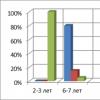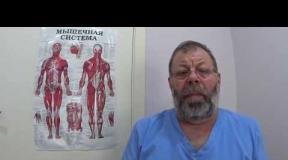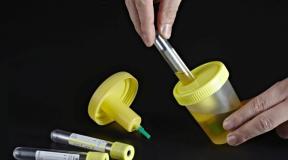Instructions for the use of Ceftriaxone injections and side effects of the antibiotic. Ceftriaxone from which injections help Recipe ceftriaxone ® in Latin
!}
Composition
One bottle contains
active substance - ceftriaxone sodium sterile, in terms of ceftriaxone - 1.0 g.
!}
Description
Crystalline powder of almost white or yellowish color. Weakly hygroscopic.
Pharmacotherapeutic group
Other beta-lactam antibacterial drugs. Third generation cephalosporins.
ATC code J01DD04.
Pharmacological properties "type =" checkbox ">
Pharmacological properties
Pharmacokinetics
The pharmacokinetics of ceftriaxone is non-linear. All major pharmacokinetic parameters based on total drug concentrations, with the exception of half-life, are dose dependent.
Suction. The maximum concentration in blood plasma after a single intramuscular injection of 1 g of the drug is about 81 mg / l and is achieved within 2-3 hours after administration. The areas under the plasma concentration-time curve after intravenous and intramuscular administration are the same. This means that the bioavailability of ceftriaxone after intramuscular administration is 100%.
Distribution. The volume of distribution of ceftriaxone is 7-12 liters. After administration in a dose of 1-2 g, ceftriaxone penetrates well into tissues and body fluids. For more than 24 hours, its concentrations far exceed the minimum inhibitory concentrations for most infectious agents in more than 60 tissues and fluids (including the lungs, heart, biliary tract, liver, tonsils, middle ear and nasal mucosa, bones, and spinal cord). , pleural and synovial fluids and prostate secretions).
After intravenous use ceftriaxone quickly penetrates into cerebrospinal fluid, where bactericidal concentrations against sensitive microorganisms are maintained for 24 hours.
Ceftriaxone binds reversibly to albumin, and the degree of binding decreases with increasing concentration, decreasing, for example, from 95% at a plasma concentration of less than 100 mg / L to 85% at a concentration of 300 mg / L. Due to the lower concentration of albumin in the interstitial fluid, the proportion of free ceftriaxone in it is higher than in plasma.
Penetration into individual tissues. Ceftriaxone penetrates the inflamed meninges in children, including newborns. 24 hours after intravenous administration at doses of 50-100 mg / kg of body weight (for newborns and infants, respectively), the concentrations of ceftriaxone in the cerebrospinal fluid exceed 1.4 mg / l. The maximum concentration in the cerebrospinal fluid is reached approximately 4 hours after intravenous administration and averages 18 mg / l. With bacterial meningitis, the average concentration of ceftriaxone in the cerebrospinal fluid is 17% of the concentration in the blood plasma, with aseptic meningitis - 4%. In adult patients with meningitis, 2-24 hours after administration of a dose of 50 mg / kg of body weight, the concentrations of ceftriaxone in the cerebrospinal fluid are many times higher than the minimum inhibitory concentrations for the most common pathogens of meningitis.
Ceftriaxone crosses the placental barrier and passes into breast milk in small concentrations.
Metabolism. Ceftriaxone does not undergo systemic metabolism, but is converted into inactive metabolites under the influence of the intestinal microflora.
Excretion. The total plasma clearance of ceftriaxone is 10-22 ml / min. Renal clearance is 5-12 ml / min. 50-60% of ceftriaxone is excreted unchanged in the urine, and 40-50% is excreted unchanged in the bile. The half-life of ceftriaxone in adults is about 8 hours.
Pharmacokinetics in special groups patients
In patients with impaired renal or liver function the pharmacokinetics of ceftriaxone changes insignificantly, there is only a slight increase in the half-life. If only renal function is impaired, excretion with bile increases, if only liver function is impaired, excretion through the kidneys increases.
Patients over 75 years old
In persons over 75 years of age, the half-life of ceftriaxone is, on average, two or three times that of young adults.
Children
In newborns, about 70% of the dose is excreted through the kidneys. In infants, in the first 8 days of life, on average, two or three times more than in adults.
Pharmacodynamics
The bactericidal activity of ceftriaxone is due to the suppression of the synthesis of cell membranes. In vitro ceftriaxone has a broad spectrum of action against gram-negative and gram-positive microorganisms. Highly resistant to most β-lactamases (both penicillinases and cephalosporinases) produced by gram-positive and gram-negative bacteria.
Ceftriaxone-KMP is usually active against the following microorganisms.
Gram-positive aerobes:
Staphylococcus aureus(methicillin-susceptible), Staphylococci coagulase negative, Streptococcus pyogenes(ß-hemolytic, group A), Streptococcus agalactiae(ß-hemolytic, groups B), ß-hemolytic streptococci (groups neither A nor B), Streptococcus viridans, Streptococcus pneumoniae.
Note. Methicillin-resistant Staphylococcus spp . resistant to cephalosporins, including ceftriaxone. Usually, Enterococcus faecalis, Enterococcus faecium and Listeria monocytogenes are also stable.
Gram-negative aerobes:
Acinetobacter lwoffi, Acinetobacter anitratus(mainly, A. baumanii)*, Aeromonas hydrophila, Alcaligenes faecalis, Alcaligenes odorans, alkaligenic bacteria, Borrelia burgdorferi, Capnocytophaga spp., Citrobacter diversus(including C. amalonaticus), Citrobacter freundii *, Escherichia coli, Enterobacter aerogenes*, Enterobacter cloacae*, Enterobacter spp . (other) *, Haemophilus ducreyi, Haemophilus influenzae, Haemophilus parainfluenzae, Hafnia alvei, Klebsiella oxytoca, Klebsiella pneumoniae **, Moraxella catarrhalis(previously called Branhamella catarrhalis), Moraxella osloensis, Moraxella spp. (others), Morganella morganii, Neisseria gonorrhoea, Neisseria meningitidis, Pasteurella multocida, Plesiomonas shigelloides, Proteus mirabilis, Proteus penneri*, Proteus vulgaris*, Pseudomonas fluorescens*, Pseudomonas spp. (other) *, Providentia rettgeri*, Providentia spp. (others), Salmonella typhi, Salmonella spp. (nontyphoidal), Serratia marcescens*, Serratia spp. (other) *, Shigella spp., Vibrio spp., Yersinia enterocolitica, Yersinia spp. (others).
* Some isolates of these species are resistant to ceftriaxone mainly due to the formation of lactamases encoded by chromosomes.
** Some isolates of these species are resistant to ceftriaxone due to the formation of a number of plasmid-mediated lactamases.
Note. Many strains of the above microorganisms that are multiresistant to other antibiotics such as aminopenicillins and ureidopenicillins, first and second generation cephalosporins and aminoglycosides are susceptible to ceftriaxone.
Treponema pallidum sensitive to ceftriaxone in vitro and in animal experiments. Clinical trials show that ceftriaxone has good efficacy against primary and secondary syphilis. With very few exceptions, clinical isolates P. aeruginosa resistant to ceftriaxone.
Anaerobes:
Bacteroides spp. (bile sensitive) *, Clostridium spp. (with the exception of C. difficile), Fusobacterium nucleatum, Fusobacterium spp. (others), Gaffkia anaerobica(previously called Peptococcus), Peptostreptococcus spp .
* Some isolates of these species are resistant to ceftriaxone due to the formation of β-lactamases.
Note. Many strains of β-lactamase-forming Bacteroides spp.(in particular, B. fragilis) are resistant to ceftriaxone. Stable and Clostridium difficile.
Indications for use
Infections caused by pathogens sensitive to the drug:
- sepsis;
- meningitis;
- disseminated Lyme disease (early and late stages of the disease);
- organ infections abdominal cavity(peritonitis, biliary tract infections and gastrointestinal tract);
- infections of bones, joints, soft tissues, skin, wound infections;
- infections in immunocompromised patients;
- kidney and urinary tract infections;
- infections respiratory tract, especially pneumonia, infections of the ENT organs;
- genital infections, including gonorrhea;
- preoperative prevention of infectious complications.
!}
Method of administration and dosage
Ceftriaxone-KMP is administered intramuscularly and intravenously. Before starting therapy with the use of Ceftriaxone-KMP, it is necessary to exclude the presence of drug intolerance in the patient by making a skin test.
Standard dosage
Adults and children over 12 years old: 1-2 g once a day (every 24 hours).
In severe cases or with infections, the causative agents of which have only moderate sensitivity to ceftriaxone, the daily dose can be increased to 4 g.
Duration of treatment depends on the course of the disease. As always with antibiotic therapy, the administration of the drug Ceftriaxone-KMP should be continued to patients for at least 48-72 hours after the temperature has returned to normal and the eradication of the pathogen is confirmed.
Combination therapy
Synergism has been shown between ceftriaxone and aminoglycosides against many gram-negative bacteria. While the increased effectiveness of such combinations is not always predictable, it should be borne in mind in the presence of severe, life-threatening infections such as Pseudomonas aeruginosa. Due to the physical incompatibility of ceftriaxone and aminoglycosides, they should be administered separately at their recommended doses.
In patients with impaired liver function there is no need to reduce the dose, provided that there is no renal dysfunction.
In patients with impaired renal function there is no need to reduce the dose, provided that there are no liver dysfunctions. The daily dose of Ceftriaxone-KMP should not exceed 2 g only in cases of renal failure with creatinine clearance less than 10 ml / min.
At a combination of severe renal and hepatic impairment the concentration of ceftriaxone in blood plasma should be regularly determined and its dose adjusted if necessary.
Patients who are on dialysis , additional administration of the drug after dialysis is not required. However, the concentration of ceftriaxone in the blood serum should be monitored for possible dose adjustments, since the rate of excretion in these patients may decrease.
Elderly and senile patients
Usual doses for adults, not age adjusted.
Children
Newborns, infants and children under 12 years of age
When prescribing the drug Ceftriaxone-KMP once a day, it is recommended to adhere to the following dosage regimens:
newborns (up to 14 days) - 20-50 mg / kg of body weight once a day. The daily dose should not exceed 50 mg / kg of body weight. In determining the dose, no distinction should be made between term and premature infants.
Newborns, infants and children younger age(from 15 days to 12 years): 20-80 mg / kg body weight once a day.
Doses for adults are prescribed for children weighing over 50 kg.
Meningitis
At bacterial meningitis in infants and young children treatment begins with a dose of 100 mg / kg (but not more than 4 g) once a day. After identification of the pathogen and determination of its sensitivity, the dose can be reduced accordingly.
The best results for meningococcal meningitis were achieved with a treatment duration of 4 days, with meningitis caused by Haemophilus influenzae – 6 days, Streptococcus pneumoniae- 7 days.
Lyme disease
50 mg / kg (highest daily dose- 2 d) for adults and children once a day for 14 days.
Gonorrhea(caused by penicillinase-forming and penicillinase-non-forming strains): a single intramuscular injection of 250 mg of the drug Ceftriaxone-KMP.
Prevention of postoperative infections
Depending on the degree of infectious risk, 1-2 g of the drug Ceftriaxone-KMP is administered once 30-90 minutes before the start of the operation. In operations on the colon and rectum, the simultaneous administration of the drug Ceftriaxone-KMP and one of the 5-nitroimidazoles, for example, ornidazole, has proven itself well.
Preparation of solutions.
It is necessary to prepare solutions immediately before their use. Freshly prepared solutions retain their physical and chemical stability for 6 hours at room temperature(or within 24 hours at a temperature of 2-8 ° C). Depending on the concentration and duration of storage, the color of the solutions can vary from pale yellow to amber. This property of the active substance does not affect the effectiveness or tolerability of the drug.
For intramuscular injection 1 g is dissolved in 3.5 ml of 1% lidocaine solution; the injection is made deep into the gluteus muscle. It is recommended to inject no more than 1 g into one buttock.
For intravenous injection dissolve 1 g of Ceftriaxone-KMP in 10 ml of sterile water for injection; injected intravenously slowly (2-4 minutes).
Intravenous infusion should last at least 30 minutes. To prepare the solution for infusion, dissolve 2 g of Ceftriaxone-KMP in 40 ml of one of the following infusion solutions free of calcium ions: 0.9% sodium chloride, 0.45% sodium chloride + 2.5% glucose, 5% glucose, 10 % glucose, 6% dextran in 5% glucose solution, 6-10% hydroxyethylated starch, water for injection. Given the possible incompatibility, solutions containing ceftriaxone should not be mixed with solutions containing other antibiotics, both during preparation and during administration.
Do not use calcium-containing solvents, such as Ringer's solution or Hartmann's solution, to dissolve Ceftriaxone-KMP in vials or to dilute the reconstituted solution for intravenous administration due to the likelihood of precipitating calcium salts of ceftriaxone. The formation of precipitates of calcium salts of ceftriaxone can also occur when Ceftriaxone-KMP is mixed with calcium-containing solutions in the same infusion system for intravenous administration. Ceftriaxone-KMP should not be administered simultaneously intravenously with calcium-containing solutions, including long-term calcium-containing infusions, for example parenteral nutrition(see "Interaction with other medicinal products and other types of interactions").
Side effects
Ceftriaxone is generally well tolerated. When using it, such side effects that regressed spontaneously or after drug withdrawal:
- diarrhea, nausea, vomiting, stomatitis, glossitis;
- eosinophilia, leukopenia, granulocytopenia, hemolytic anemia, thrombocytopenia, increased prothrombin time;
- mycosis of the genital tract, secondary fungal infections and infections caused by resistant microorganisms.
Rarely
- headache and dizziness, fever, chills, and anaphylactic or anaphylactoid reactions;
- rash, allergic dermatitis, itching, urticaria, edema, exanthema;
- pancreatitis;
- oliguria, hematuria, glucosuria, increased serum creatinine levels.
Very rarely
- pseudomembranous enterocolitis;
- agranulocytosis (< 500/мм3), преимущественно после применения общей дозы 20 г или больше. Во время длительного лечения следует регулярно контролировать картину крови;
- exudative erythema multiforme (Stevens-Johnson syndrome), toxic epidermal necrolysis (Lyell's syndrome);
- disorders of coagulation;
- precipitates of calcium salt of ceftriaxone in gallbladder with appropriate symptoms in children, reversible cholelithiasis in children (these phenomena were rarely observed in children); common - an increase in the level of liver enzymes in the blood serum (AST, ALT, alkaline phosphatase);
- the formation of calculi in the kidneys, mainly in children from 3 years of age who received large daily doses of the drug (≥ 80 mg / kg per day) or cumulative doses over 10 g, as well as in the presence of additional risk factors (limited fluid intake, bed rest). The formation of calculi in the kidneys may be asymptomatic or manifest clinically, and may lead to renal failure, which resolves after stopping ceftriaxone treatment.
In isolated cases there are inflammatory reactions of the vein wall. They can be avoided by applying a slow injection (2-4 minutes). Intramuscular injection without lidocaine is painful.
!}
Contraindications
- hypersensitivity to cephalosporins (if the patient has hypersensitivity to penicillin, the possibility of a cross-allergic reaction to ceftriaxone should be taken into account);
- age of premature babies ≤ 41 weeks, taking into account the period of intrauterine development (gestational age + age after birth);
- neonatal period up to 28 days with: hyperbilirubinemia (due to the ability of ceftriaxone to displace bilirubin from association with serum albumin, which can lead to the risk of developing encephalopathy caused by bilirubin), the need (or expected need) of treatment with intravenous calcium-containing solutions, including intravenous calcium-containing infusions, for example parenteral nutrition, due to the risk of precipitation of calcium salts of ceftriaxone.
Drug interactions "type =" checkbox ">
Drug interactions
In no case should Ceftriaxone-KMP be used with calcium-containing solutions (Ringer's solution, etc.). Calcium-containing solutions should not be administered within 48 hours after the last administration of Ceftriaxone-KMP.
In newborns and premature babies, there are cases of formation of precipitates in the lungs and kidneys, resulting in lethal consequences with the simultaneous administration of Ceftriaxone-KMP and calcium preparations.
With the simultaneous use of high doses of Ceftriaxone-KMP and such potent diuretics as furosemide, no renal dysfunction was observed.
There is no evidence that Ceftriaxone-KMP increases the renal toxicity of aminoglycosides. After taking alcohol immediately after taking Ceftriaxone-KMP, no effects similar to the action of disulfiram (teturam) were observed.
Ceftriaxone-KMP does not contain the N-methylthiotetrazole group, which could cause ethanol intolerance, as well as bleeding, which is characteristic of some other cephalosporins.
Probenecid does not affect the elimination of Ceftriaxone-KMP.
There is an antagonism between chloramphenicol and ceftriaxone-KMP.
Do not use calcium-containing solvents such as Ringer's solution or Hartmann's solution to dissolve Ceftriaxone-KMP in vials or to dilute the reconstituted solution for intravenous administration due to the likelihood of precipitates of calcium salts of Ceftriaxone-KMP. The formation of precipitates of calcium salts of ceftriaxone can also occur when Ceftriaxone-KMP is mixed with calcium-containing solutions in the same infusion system for intravenous administration. Ceftriaxone should not be administered intravenously simultaneously with calcium-containing solutions, including long-term calcium-containing infusions, for example, parenteral nutrition (see "Dosage and Administration"). Infants have an increased risk of precipitating calcium salts of ceftriaxone.
Ceftriaxone-KMP is incompatible with amzacrine, vancomycin, fluconazole and aminoglycosides.
Bacteriostatic agents can interfere with the bactericidal effect of cephalosporins.
Ceftriaxone-CMP may decrease the effectiveness of hormonal oral contraceptives. In this regard, it is recommended to use additional (non-hormonal) methods of contraception during treatment and within 1 month after treatment.
There are no reports of interactions between Ceftriaxone-CMP and calcium-containing products for oral administration and interactions between Ceftriaxone-CMP when injected intramuscularly and calcium-containing products (intravenous or oral).
special instructions "type =" checkbox ">
special instructions
As with the use of other cephalosporins, with the use of Ceftriaxone-KMP, anaphylactic reactions with a fatal outcome are possible, even if there is no corresponding indication in a detailed history. If allergic reactions occur, ceftriaxone should be discontinued immediately and appropriate treatment should be prescribed.
Ceftriaxone-KMP can increase prothrombin time. In this regard, if a vitamin K deficiency is suspected, it is necessary to determine the prothrombin time.
Against the background of the use of almost all antibacterial drugs, including Ceftriaxone-KMP, the development of diarrhea associated with Clostridium difficile, from mild severity to fatal colitis. Antibacterial drugs alter the normal flora of the large intestine, resulting in overgrowth Clostridium difficile. Clostridium difficile produces toxins A and B, which contribute to the development of diarrhea associated with Clostridium difficile... Strains Clostridium difficile over-producing toxins cause increased morbidity and mortality, as these infections may be resistant to antimicrobial agents and require colectomy. Diarrhea associated with Clostridium difficile should be ruled out in all patients during antibiotic use. A detailed medical history should be taken as diarrhea associated with Clostridium difficile, can occur within two months after the end of the use of antibacterial agents. If you suspect or confirm diarrhea associated with Clostridium difficile, it is necessary to cancel antibiotic therapy that does not affect Clostridium difficile... By clinical indications an appropriate amount of fluids and electrolytes, protein supplements, antibiotic therapy to which she is sensitive should be prescribed Clostridium difficile, and surgical examination.
During long-term use of Ceftriaxone-KMP, difficulties in controlling microorganisms that are insensitive to the drug are possible. In this regard, careful monitoring of patients is required. With the development of superinfection, it is necessary to take appropriate measures.
After using Ceftriaxone-KMP in doses exceeding the standard recommended, with ultrasound examination gallbladder shadows can be observed that are mistaken for stones. These are precipitates of the calcium salt of ceftriaxone, which disappear upon completion or discontinuation of ceftriaxone-KMP therapy. Such changes are rarely accompanied by any symptoms. But even in such cases, it is only recommended conservative treatment... If these phenomena are accompanied by clinical symptoms, then the doctor makes the decision to discontinue the drug.
In patients who received Ceftriaxone-KMP, isolated cases of pancreatitis have been described, which developed, possibly due to obstruction of the biliary tract. Most of these patients had risk factors for biliary congestion, such as a history of treatment, severe illness, and all-parenteral nutrition. At the same time, the role of precipitates formed under the action of Ceftriaxone-KMP in the biliary tract cannot be ruled out in the development of pancreatitis.
Ceftriaxone-KMP can displace bilirubin from its association with serum albumin. In this regard, the use of Ceftriaxone-KMP in newborns with hyperbilirubinemia is contraindicated (see section "Contraindications").
Ceftriaxone should be used with caution in patients with renal failure who are simultaneously receiving aminoglycosides and diuretics.
In newborns and premature babies, cases of formation of precipitates in the lungs and kidneys have been described, which caused fatal consequences with the simultaneous administration of Ceftriaxone-KMP and calcium preparations.
There are known cases of the formation of intravascular precipitates in patients of other age groups after the simultaneous use of Ceftriaxone-KMP with intravenous calcium-containing solutions. In this regard, it is impossible to use calcium-containing solutions for intravenous administration to newborns and patients of other age groups for at least 48 hours after the administration of the last dose of Ceftriaxone-KMP (see section "Contraindications").
Immune-mediated hemolytic anemia has been observed in patients treated with cephalosporins, including ceftriaxone. There are known cases of severe hemolytic anemia, including lethal, in adults and children. With the development of anemia during the use of Ceftriaxone-KMP, it is necessary to exclude the anemia caused by Ceftriaxone-KMP, and to cancel the drug until the etiology of the anemia is established. During long-term treatment, the blood picture should be regularly monitored.
In isolated cases, when treated with Ceftriaxone-KMP, patients may experience false-positive results of the Coombs' reaction. Like other antibiotics, ceftriaxone can cause a false positive test for galactosemia. False positive results can also be obtained when determining glucose in urine, therefore, during treatment with Ceftriaxone-KMP, glucosuria, if necessary, should be determined only by the enzymatic method.
Pregnancy and lactation
Ceftriaxone-KMP crosses the placental barrier. The safety of ceftriaxone for women during pregnancy has not been studied. In small concentrations, ceftriaxone passes into breast milk. Therefore, when prescribing Ceftriaxone-KMP, breastfeeding should be discontinued.
Features of influence medicinal product the ability to drive a vehicle or potentially dangerous machinery
There is no data on the effect of Ceftriaxone-CMP on the reaction rate, but due to the possibility of dizziness, ceftriaxone may affect the ability to manage vehicles or work with complex mechanisms.
!}
Overdose
In case of overdose, hemodialysis or peritoneal dialysis will not decrease the concentration of the drug. There is no specific antidote. Overdose treatment is symptomatic.
Retention period "type =" checkbox ">
Shelf life
Do not use after the expiry date indicated on the package!
!}
Conditions of dispensing from pharmacies
On prescription.
Manufacturer
PJSC "Kievmedpreparat"
Ukraine, 01032, Kiev, st. Saksaganskogo, 139.
Marketing Authorization Holder
PJSC "Kievmedpreparat", Ukraine
Ceftriaxone ® is a class 3 bactericidal antibiotic. The drug is characterized by prolonged action and high efficiency against most gram-negative and gram-positive pathogens, including strains that release penicillinases and cephalosporinases.
The price depends on the manufacturer. Russian Ceftriaxone ®, regardless of the manufacturer, belongs to inexpensive antibiotics. For example, an ampoule (1 g) produced by the pharmaceutical company Synthesis ACOMP ® will cost the buyer 27 rubles, Biochemist ® Saransk - 29 rubles, and Lecco ® - 36 rubles.
Swiss Ceftriaxone ® produced by the pharmaceutical company Hoffmann la Roche ® costs about 550 rubles per ampoule.
Possesses powerful bactericidal activity and ultra wide spectrum of antimicrobial effects. The mechanism of the antibacterial action of Ceftriaxone ® is realized due to the active acetylation of membrane-bound transpeptidases, leading to destabilization of the cross-linking of the supporting polymers in the bacterial cell. Violation of the membrane strength leads to rapid cell death.
It should be noted that the drug is able to cross the placental barrier, therefore, Ceftriaxone® during pregnancy is not recommended to be administered in the 1st trimester. During lactation, up to four percent of the concentration of the antibiotic in the blood can be excreted along with breast milk.
The required bactericidal parameters in the blood are achieved 1.5 hours after administration. Since the drug has a prolonged effect, the minimum antimicrobial concentration in the body is maintained in the blood for a day, which allows it to be administered once a day. However, with severe course infection or a high risk of complications, it is preferable to divide the daily dose into 2 administrations. This allows for the maintenance of higher bactericidal concentrations. Also, you should divide the daily dose by 2 times when prescribing high doses.
In patients over seventy-five years of age, the elimination period is lengthened due to age-related decline in renal function. In this regard, it may be necessary to adjust the prescribed dose. It is preferable to administer the daily dose to such patients at one time.
The elimination of this drug from the body is carried out mainly in the urine. Part of the drug is disposed of with bile.
Pharmacological group
The drug belongs to the third generation cephalosporin antibiotics.
Ceftriaxone ® - release form
Has only injection form release. The antibiotic is sold in pharmacies with a doctor's prescription.
The pharmacological group of ceftriaxone is parenteral of the third generation, that is, it can only be used intramuscularly or intravenously. Sold in ampoules of 500, 1000 and 2000 mg. Rocefin is available additionally at a dosage of 250 mg.
Photo of ceftriaxone Kabi 1000 mg powder for solution for intravenous and intramuscular administration
Ceftriaxone® Prescription in Latin
Ceftriaxone ® in Latin - Ceftriaxoni.
Rp .: Ceftriaxoni 1.0
S. In the supplied solvent i / m, once a day.
Ceftriaxone ® - composition of the drug
The antibiotic is produced in the form sodium salt... The active ingredient - ceftriaxone, easily penetrates into body fluids and environments, significantly accumulates in inflamed tissues. With inflammation of the meninges, the antibiotic can accumulate in the cerebrospinal fluid.
Rofecin ® - in the form of a disodium derivative (disodium hydrate). Each ampoule of Rofecin ® is completed with a solvent (lidocaine or injection water).
What does Ceftriaxone ® help from?
The antibiotic has an ultra-wide spectrum of antimicrobial effects, covering staphylococci, pneumococci, citrobacter, most of the enterobacter strains, Escherichia coli, Ducrey's bacillus, Haemophilus influenzae, Klebsiella, Moraxella, gonococci, meningococci, some cloves and proteus, and proteus , peptococci, peptostreptococci, white treponema.
Methicillin-resistant staphylococci, some enterococci, listeria, bacteroids and clostridium deficiency have absolute resistance to Ceftriaxone ®.
Ceftriaxone ® - indications for use
An antibiotic can be used for:
- bacterial lesion of the OBP (abdominal organs). It can be prescribed for the treatment of abscess, phlegmon, empyema of the gallbladder, bacterial inflammation of the bile ducts, peritonitis, etc.;
- infections of ENT - organs and respiratory organs. systems (including complicated ones, abscesses of lung tissue, pleural empyema);
- carriage of Salmonella and;
- typhoid fever;
- osteomyelitis, septic arthritis,;
- bacterial damage to the skin and SFA, including burns complicated by bacterial flora, etc .;
- Lyme disease;
- infectious pathologies of the genitourinary system (including gonorrhea, chancre, syphilis);
- endocarditis;
- generalization of infection (development of sepsis);
- infections in patients with;
- preventive therapy before performing surgery on the OBP and pelvic organs.
Ceftriaxone ® - contraindications
An allergy to the drug or other beta-lactam antibiotics is an absolute contraindication. This is due to the fact that, among all beta-lactams, there is a risk of developing cross-allergic reactions.
Also, it is not prescribed in the 1st trimester of pregnancy and women who are breastfeeding.
Considering the mechanism of utilization (urine and bile), it can be prescribed for renal or liver dysfunction, but is not used for combined renal-hepatic failure.
The drug is contraindicated in premature babies less than 41 weeks of age, taking into account the gestational age and age after birth. It is also contraindicated in newborns with hyperbilirubinemia.
Against the background of antibiotic treatment, it is forbidden to inject intravenous calcium solutions, since there is a risk of precipitation of Ca salt of Ceftriaxone ®.
The remedy can be prescribed to children from the first days of life, however, up to two weeks of life can be used only for health reasons. This is due to its ability to displace bilirubin from its association with serum albumin. This can lead to the development of hyperbilirubinemia and cause kernicterus.
Given the partial disposal with bile, the drug is not prescribed for patients with obstruction of the biliary tract.
The antibiotic on lidocaine is not administered to children under 12 years of age.
Also, it must be borne in mind that lidocaine is contraindicated in women carrying a child, breastfeeding, patients with atrioventricular block, HF (heart failure), SVC or Stokes-Adams syndrome, weakness of the sinus node, complete transverse blockade, severe bradyarrhythmia or severe pressure reduction.
Ceftriaxone ® - dosage
Introduced intravenously in 10 ml nat. solution 0.9%. The drug should be administered slowly, over two to four minutes.
Intramuscularly it is administered on lidocaine, physical. solution, water for injection. In / m is not recommended to enter more than a gram. Higher dosages are given intravenously.
After 12 years, 1 g of medium is administered 1-2 times a day. In a severe course of the disease, a maximum of four grams per day can be administered (two times, with an interval of 12 hours).
Babies under the age of 2 weeks of life are prescribed 20-50 mg / kg per day for 1 administration.
Bacterial meningitis is an indication for the administration of one hundred mg / kg of the drug per day during the initial therapy. In the future, the dose is reduced.
From 14 days to 12 years 20-80 mg / kg per knock. If the child weighs more than 50 kg, adult doses must be prescribed.
For patients with renal pathologies, the dose is reduced in accordance with the GFR. Liver dysfunction is also an indication for a decrease in the daily dose.
How many times a day should an adult be injected with Ceftriaxone?
The drug is administered 1-2 times a day. In case of severe infection, the risk of complications, the appointment of high doses of the drug, as well as the presence of an immunodeficiency in the patient, it is preferable to divide the daily dose into two injections.
Ceftriaxone ® - side effects
The antibiotic is generally well tolerated by patients. However, the risk of developing allergic reactions should be considered. They can have varying degrees of severity from redness and rash at the injection site, urticaria, to Quincke's edema or anaphylactic shock.
The risk of anaphylaxis is increased when administered on lidocaine. Therefore, when appointing a medium, a test is mandatory. Also, contraindications and restrictions to the use of lidocaine are taken into account.
It is forbidden to independently prescribe a drug to oneself, adjust dosages and duration of treatment. Therapy should be carried out in a stationary setting, under the supervision of the attending physician.
Other undesirable effects can be manifested by dyspeptic reactions, diarrhea, phlebitis at the injection site, dysbiosis, thrush, changes in the OAC and biochemical analysis... Coagulation disorders are rare (the antibiotic inhibits the intestinal microflora that synthesizes vitamin K) and, as a rule, is typical for patients receiving antiplatelet therapy.
In rare cases, the development of antibiotic-associated diarrhea is possible.
Ceftriaxone during pregnancy and breastfeeding
The antibiotic is able to cross the placental barrier, but does not have embryotoxic and teratogenic effects. Ceftriaxone® during pregnancy is not recommended for administration in the first trimester, as there is insufficient data on its safety in this category of patients. Controlled animal studies have not shown toxic action on the fetus, therefore, antibiotics can be used in the 2nd and 3rd trimester.
Ceftriaxone® during lactation can be excreted in breast milk, therefore, when it is prescribed to women who are breastfeeding, it is recommended to temporarily stop natural feeding. This is due to the fact that an antibiotic released with breast milk can cause sensitization of the baby, the development of thrush. oral cavity and intestinal dysbiosis.
Ceftriaxone ® and alcohol - compatibility
Ceftriaxone® and alcohol are categorically incompatible. Firstly, given that it is partially utilized by the liver, such a combination can lead to the development of jaundice and medicinal hepatitis.
Secondly, the use of alcoholic beverages against the background of antibiotic therapy can cause severe intoxication and toxic damage to the kidneys.
Thirdly, this can lead to the development of a severe disulfiram-like reaction. It can manifest itself as tachycardia, chills, tremors of the limbs, seizures, impairment heart rate, arterial hypotension, up to collapse.
Allergy to Ceftriaxone ®
It is not prescribed for patients with allergies to other beta-lactams, due to the high risk of developing a cross-allergic reaction.
Also, a sample should always be set before administration.
Allergic manifestations can range from urticaria to anaphylaxis (in the absence of timely medical care, death is possible).
Fatalities are associated with its breeding and administration with lidocaine. Given the risk of anaphylactic shock, it is strictly prohibited self-treatment antibiotic. The drug should be used exclusively in a hospital setting, after sample preparation.
The drug diluted with lidocaine is administered only intramuscularly, intravenous administration is categorically contraindicated.
When administered intramuscularly, 250 or 500 mg of the medium is diluted in two ml of 1% lidocaine ®. One gram of antibiotic is diluted with 3.5 milliliters of 1% lidocaine ®.
If 2% lidocaine is used, injectable water should be used additionally. When 250 and 500 ml of an antibiotic are administered, it is diluted with 1 ml of lidocaine ® (2%) and 1 ml of water for injection. One gram of antibiotic is diluted with 1.8 ml of lidocaine ® + 1.8 ml of injectable water.
Can ceftriaxone ® be diluted with novocaine?
Recent studies have shown that the drug should not be diluted with novocaine for administration. Its use is associated with the risk of developing anaphylaxis. It also reduces the activity of cephalosporin and, worse than lidocaine, relieves pain.
Ceftriaxone ® injections - doctors' reviews
The drug has repeatedly proven its effectiveness in the treatment of infections of the ENT organs and respiratory organs. system, infections with OBP, skin, etc.
However, it must be remembered that the remedy should only be used as directed and under the supervision of a physician. This will reduce the risk of developing unwanted effects.
Patients report rapid and sustained improvement. Negative reviews of the drug are most often associated with its painfulness when administered intramuscularly.
Ceftriaxone is a powerful antibiotic. In medical practice, it has become no less popular than penicillin. The drug affects most of the known harmful bacteria, and has helped many infected patients. In many cases, the use of the drug Ceftriaxone is justified.
The injections of the drug cause pain and sometimes allergic reactions. But attempts to replace ceftriaxone with analogs lead to an increase in the cost of treatment. Then how to replace Ceftriaxone in injections? How effective is it in the fight against syphilis and prostatitis? Let's compare its properties with Penicillin, Rocephin and Azaran?
An antibacterial cephalosporin agent that has a powerful inhibitory effect on the bacterial membrane is called ceftriaxone. Injections (intravenous and intramuscular) are the main route of administration of the drug into the body. Oral administration is not provided, only injections.
Ceftriaxone: what does this drug help with?
Ceftriaxone has been successfully used to combat infectious and inflammatory diseases:
- Respiratory organs (meningitis, pneumonia, pleurisy, bronchitis, epiglottitis, sinusitis, lung abscess);
- Urogenital infections (urethritis, pyelonephritis, cystitis, epidirmitis, pyelitis);
- Prostate gland (prostatitis);
- Sexually transmitted diseases (syphilis, gonorrhea, chancroid);
- Furunculosis;
- Abdominal cavity (angiocholitis, peritonitis);
- Skin (streptoderma);
- With otitis media;
- Typhoid fever;
- Bacterial septicemia;
- Related to bone, skin and joints;
- Tick-borne borreliosis (Lyme disease).
To stabilize health after different types operations (removal of appendicitis, gallbladder, postpartum) are also prescribed injections of ceftriaxone.

Instructions for use are mandatory. The medicine is dispensed at the pharmacy after a doctor's prescription.
Ceftriaxone dosage is an important part of prevention and treatment
For children over 12 years old (weighing 50 kg) and adults, the daily dosage is 1-2 g. This volume can be divided into two administrations (after 12 hours). When treating severe infections the dosage is increased to 4 grams. No more than 2 g is introduced at a time.
For children under 12 years of age, the use of cephalosporins is not recommended, it is prescribed in extreme cases in the following proportions:
- For children under 2 weeks of age - up to 50 mg per kg / day;
- For children under 12 years old (weighing up to 50 kg), the maximum dosage is up to 80 mg per kg / day.
Ceftriaxone can be administered by drip over 30 minutes.
The dosing accuracy is selected by the doctor, based on the severity and type of infection, the age and condition of the patient.
The duration of the course is at least 5 days. It can be up to 2-3 weeks. It is selected so that the eradication of the infection ends two days before the end of therapy.
Preparation of Ceftriaxone before injection
Ceftriaxone is diluted with a liquid for injection, anesthetic (Lidocaine, Novocaine). All antibiotic shots are painful.

1 gram of ceftriaxone is diluted with 4 ml of lidocaine.
The procedure for preparing Ceftriaxone solution:
- An ampoule with a solvent is opened;
- The aluminum cap on the bottle with Ceftriaxone is folded back (the rim of the cap cannot be removed);
- The syringe is filled with 4 ml of Lidocaine or Novocaine;
- 4 ml of anesthetic is injected into a container with Ceftriaxone powder and stirred.
Ceftriaxone is poorly soluble, stirring must be done thoroughly. The finished solution has a light yellow color.
Ceftriaxone injections: side effects
Central nervous system may show symptoms of insensitivity to the composition of the drug through migraines. Side effects of Ceftriaxone include allergies, itching, and rarely anaphylactic shock (Quincke's edema).
Swelling may occur at the injection site. Temporary hypoprothrombinemia or phlebitis may occur.
When using Ceftriaxone, there are risks of getting angioedema. 10-20% of such cases end in death, which shows the importance of planning treatment measures, prescribing a dosage and constant monitoring of the patient's condition and analyzes.
In hemodialysis, plasma and blood measurements are constantly taken from the patient to detect an increased concentration of the drug. Prolonged treatment disrupts the functioning of the liver and kidneys. Vitamin K is often given to patients (especially the elderly).

Exceeding the dosage is prohibited, as it leads to the destruction of the intestinal microflora (dysbiosis), decay occurs digestive system.
Interaction of ceftriaxone with ethyl alcohol causes disulfiram-like effects.
The use with other β-lactam antibiotics is also not permissible, as it causes:
- Hyperemia;
- Vomiting;
- Tachycardia;
- Headache;
- Abdominal cramps;
- Various bleeding.
When side effects appear, the drug is stopped.
What can ceftriaxone be diluted with? Instructions for use: injections with lidocaine.
It is recommended to dilute Ceftriaxone powder with 10% lidocaine solution or sterile injection liquid. Ceftriaxone in liquid form must be administered no later than 6 hours after preparation. Using a refrigerator increases the shelf life of the drug to 24 hours.
Ceftriaxone is used to treat syphilis
The use of penicillin to treat syphilis (Treponema pallidum) is the main therapy. Ceftriaxone is prescribed for people who are allergic to penicillin.
The irreplaceable properties of Ceftriaxone are:
- Ability to suppress bacterial cell formation;
- Fast and complete penetration into the cells of the body; syphilis is the only infection that has a detrimental effect on the cerebrospinal fluid (cerebrospinal fluid in which the entire central nervous system is immersed) and forms a disease such as neurosyphilis.
Ceftriaxone is the most active 3rd generation cephalosporin in relation to the following organisms:
- N.gonorrhoeae (gonococcus);
- N.meningitidis (meningococcus);
- H.influenzae (Pfeiffer's wand).
The pharmacokinetics of the drug for absorption is not inferior to analogues, the distribution and absorption into the organs has high rates, and the excretion is about 8 hours.
An important feature of Ceftriaxone is its penetration through the blood-brain barrier.
3rd generation cephalosporins are actively used in chemotherapy infectious diseases due to their high activity against gram-negative microorganisms.
Until the 80s. Penicillin remained the main drug for the treatment of syphilis, even with high rates of allergic reactions in patients. Other known drugs (tetracyclines, macrolides) had lower activity for this disease and were considered less effective.

Ceftriaxone has become a new antibiotic that is almost equal in effectiveness to penicillin and has better pharmacokinetic properties.
Ceftriaxone is able to inhibit and even completely suppress the vital activity of infectious gram-positive (staphylococci, streptococci, gas gangrene, tetanus infection, anthrax) and gram-negative (moraxella catarrhalis, legionella, klebsiella, meningococcus, pneumococcus, pylori, salmonacchiasis).
The key point in the detrimental effect of harmful bacteria on the body is their ability to penetrate the tissues into the cerebrospinal fluid. The drug Ceftriaxone has the same property. The practical experience of using Ceftriaxone against syphilis continues to be investigated, and began the drug as an alternative treatment for penicillin intolerance.
Today, Ceftriaxone is used on an equal basis with Penicillin and, in a number of parameters, is more applicable to infectious prophylaxis. Included in international practice for the treatment of syphilis, neurosyphilis, HIV-infected.
Ceftriaxone for prostatitis
Prostatitis, due to its ability to progress quickly, requires prompt treatment. Otherwise, it will bring complications after fixing chronic form... Treatment includes antibacterial therapy broad spectrum antibiotics.
Most commonly used for the treatment of prostatitis:
- Amoxiclav has an antibacterial effect due to amoxicillin and clavulanic acid present in the preparation. Effective. General improvement is observed after 2-3 days of use. Not expensive. Form - suspension, tablets, injections. The latter are prescribed in cases of chronic prostatitis. Cannot be prescribed if the patient has had hepatitis.

- Ofloxacin is used for chronic prostatitis, cystitis, pyelonephritis with tablets or injections. It has anti-adaptive properties. Affects the DNA of the infection. Ofloxanin is prohibited for use by patients with stroke, TBI, or when diagnosing any circulatory disorders of the brain. Can be combined with other medicines.

- Ciprofloxacin is also used to treat chronic prostatitis. Release form - tablets that must be taken with water. The advantage of the drug is the ability to destroy not only active infection, but also incubation bacteria. It is not used for diseases of the rectum. Positive changes are observed 2 days after the start of application.

- Ceftriaxone is the most effective cephalosporin for treating acute, chronic and purulent prostatitis. Begins action immediately after injection. Facilitates urination after 12 hours. Not recommended for use in liver and kidney diseases.
Ceftriaxone: analogs in injections
You can replace ceftriaxone with more expensive analogues - Swiss Rocefin or Serbian Azaran. Their use is similar to the considered antibiotic and has similar contraindications. The maximum concentration is reached after 3-5 hours of absorption.

A solution for injection is prepared in the same way: the powder is diluted with liquid or lidocaine. The color of Azaran powder is pale yellow, Rocephina is pale. Ceftriaxone has a pale or yellowish color. The price of injections with ceftriaxone is about 30 rubles per ampoule, with Azaran - about 1,520 rubles per ampoule, with Rocefin - about 520 rubles.

The considered drugs are completely absorbed into the bloodstream. Easily absorbed into body tissues (bones, joints, spinal cord, respiratory tract, ureter, skin, abdominal cavity).
There are other analogs:
- Oframax;
- Betasporin;
- Biotraxon;
- Cephson;
- Lifaxon;
- Chizon;
- Cefatrin;
- Cefaxone;
- Ceftriaxone-AKOS;
- Ceftriaxone-Vial;
- Ceftriaxone-KMP;
 Cefaxone
Cefaxone 
Features of taking the drug for pregnant and lactating
The drug is contraindicated in pregnant women (its use in the first trimester is critical). The use of cephalosporins during lactation is not recommended, and if prescribed, breastfeeding is discontinued.
Ceftriaxone - can I drink instead of an injection?
Ceftriaxone in undiluted form is a powder, it cannot be used orally: it will not have the desired effect, but it can intensify side effects.

Ceftriaxone injections: reviews
Ceftriaxone has proven to be effective antibiotic acting on most of the known bacteria. It helps in the treatment of many infectious diseases of the abdominal cavity, pneumonia and respiratory diseases, as well as in the fight against venereal diseases.
Patients complain of discomfort (pain) after Ceftriaxone - the injection site hurts. Lidocaine partially solves the problem. The instructions are not recommended for people who are sensitive to penicillin.
conclusions
Clinical practice today is unthinkable without Ceftriaxone, which appeared in the Swiss pharmaceutical company "Hoffman La Roche" in 1978. It was the first synthetic cephalosporin of the 3rd generation, and two years later the drug received the trade name Rocefin. Its capabilities are still being explored. In 1987, Rocephin became the top-selling drug produced by Hoffman La Roche.
Ceftriaxone is included in the WHO list, which means the undeniable importance of the drug for humanity.
Catad_pgroup Antibiotics cephalosporins
Ceftriaxone - instructions for use
Registration number
Trade name of the drug: Ceftriaxone
International non-proprietary name:
CeftriaxoneChemical name:] -7 - [[(2-Amino-4-thiazolyl) (methoxyimino) acetyl] amino] -8-oxo-3 - [[(1,2,5,6-tetrahydro-2-methyl-5,6- dioxo-1,2,4-triazin-3-yl) thio] methyl] -5-thia-1-azabicyclo oct-2-ene-2-carboxylic acid (as disodium salt).
Composition:
One bottle contains 1.0 g of Ceftriaxone sodium salt.Description:
Almost white or yellowish crystalline powder.
Pharmacotherapeutic group:
antibiotic, cephalosporinATX code.
Pharmacological properties
Ceftriaxone is a third generation cephalosporin antibiotic for parenteral use, has a bactericidal effect, inhibits the synthesis of the cell membrane, in vitro inhibits the growth of most Gram-positive and Gram-negative microorganisms. Ceftriaxone is stable against beta-lactamase enzymes (both penicillinase and cephalosporinase produced by most Gram-positive and Gram-negative bacteria). In vitro and under conditions clinical practice Ceftriaxone is usually effective against the following microorganisms:
Gram-positive:
Staphylococcus aureus, Staphylococcus epidermidis, Streptococcus pneumoniae, Streptococcus A (Str.pyogenes), Streptococcus V (Str.agalactiae), Streptococcus viridans, Streptococcus bovis.
Note: Staphylococcus spp., Resistant to methicillin, is resistant to cephalosporins, including ceftriaxone. Most strains of enterococci (eg Streptococcus faecalis) are also resistant to ceftriaxone.
Gram-negative:
Aeromonas spp., Alcaligenes spp., Branhamella catarrhalis, Citrobacter spp., Enterobacter spp. (some strains are resistant), Escherichia coli, Haemophilus ducreyi, Haemophilus influenzae, Haemophilus parainfluenzae, Klebsiella spp. (including Kl. pneumoniae), Moraxella spp., Morganella morganii, Neisseria gonorrhoeae, Neisseria meningitidis, Plesiomonas shigelloides, Proteus mirabilis, Proteus vulgaris, Providencia spp., Pseudomonas aeruginosa (some strains are resistant). (including S. typhi), Serratia spp. (including S. marcescens), Shigella spp., Vibrio spp. (including V. cholerae), Yersinia spp. (including Y. enterocolitica)
Note: Many strains of the listed microorganisms, which in the presence of other antibiotics, for example, penicillins, cephalosporins of the first generation and aminoglycosides, multiply steadily, are sensitive to ceftriaxone. Treponema pallidum is sensitive to ceftriaxone both in vitro and in animal studies. According to clinical data, ceftriaxone is highly effective in primary and secondary syphilis.
Anaerobic pathogens:
Bacteroides spp. (including some strains of B. fragilis), Clostridium spp. (including CI. difficile), Fusobacterium spp. (except F. mostiferum. F. varium), Peptococcus spp., Peptostreptococcus spp.
Note: Several strains of many Bacteroides spp. (eg B. fragilis), which produce beta-lactamase, are resistant to ceftriaxone. To determine the sensitivity of microorganisms, it is necessary to use discs containing ceftriaxone, since it has been shown that in vitro certain strains of pathogens can be resistant to classical cephalosporins.
Pharmacokinetics:
When administered parenterally, ceftriaxone penetrates well into tissues and body fluids. In healthy adults, ceftriaxone has a long elimination half-life of about 8 hours. Areas under the concentration-time curve in serum for intravenous and intramuscular administration are the same. This means that the bioavailability of ceftriaxone when administered intramuscularly is 100%. When administered intravenously, ceftriaxone rapidly diffuses into the interstitial fluid, where it retains its bactericidal effect against pathogens susceptible to it for 24 hours.
The half-life in healthy adult subjects is about 8 hours. In newborns up to 8 days old and in the elderly over 75 years of age, the average elimination half-life is approximately twice as long. In adults, 50-60% of ceftriaxone is excreted unchanged in the urine, and 40-50% is also excreted unchanged in the bile. Under the influence of the intestinal flora, ceftriaxone is converted into an inactive metabolite. In newborns, approximately 70% of the administered dose is excreted by the kidneys. With renal failure or with liver pathology in adults, the pharmacokinetics of ceftriaxone almost does not change, the elimination half-life is slightly lengthened. If renal function is impaired, excretion with bile increases, and if liver pathology occurs, then the excretion of ceftriaxone by the kidneys increases.
Ceftriaxone binds reversibly to albumin and this binding is inversely proportional to the concentration: for example, when the concentration of the drug in the blood serum is less than 100 mg / L, the binding of ceftriaxone to proteins is 95%, and at a concentration of 300 mg / L it is only 85%. Due to the lower content of albumin in the interstitial fluid, the concentration of ceftriaxone in it is higher than in the blood serum.
Penetration into the cerebrospinal fluid: In infants and children with inflammation meninges ceftriaxone penetrates into the cerebrospinal fluid, while in the case of bacterial meningitis on average, 17% of the concentration of the drug in the serum diffuses into the cerebrospinal fluid, which is about 4 times more than in aseptic meningitis. 24 hours after intravenous administration of ceftriaxone at a dose of 50-100 mg / kg of body weight, the concentration in the cerebrospinal fluid exceeds 1.4 mg / l. In adult patients with meningitis, 2-25 hours after the administration of ceftriaxone at a dose of 50 mg / kg of body weight, the concentration of ceftriaxone was many times higher than the minimum depressant dose required to suppress the pathogens that most often cause meningitis.
Indications for use:
Infections caused by pathogens susceptible to ceftriaxone: sepsis, meningitis, abdominal infections (peritonitis, inflammatory diseases of the gastrointestinal tract, biliary tract), infections of bones, joints, connective tissue, skin, infections in patients with reduced function immune system, kidney and urinary tract infections, respiratory tract infections, especially pneumonia, and ear, nose and throat infections, and genital infections, including gonorrhea. Prevention of infections in the postoperative period.Method of administration and dosage:
For adults and children over 12 years old: The average daily dose is 1–2 g of ceftriaxone once a day (after 24 hours). In severe cases or in cases of infections caused by moderately susceptible pathogens, the single daily dose may be increased to 4 g.For newborns, infants and children under 12 years of age: For a single daily dosage, the following regimen is recommended:
For newborns (up to 2 weeks of age): 20-50 mg / kg of body weight per day (the dose of 50 mg / kg of body weight cannot be exceeded due to the immature enzyme system of newborns).
For infants and children under 12 years of age: the daily dose is 20-75 mg / kg of body weight. In children weighing 50 kg or more, the adult dosage should be followed. Doses greater than 50 mg / kg body weight must be given as an intravenous infusion for at least 30 minutes.
Duration of therapy: depends on the course of the disease.
Combination therapy:
Experiments have shown that there is synergy between ceftriaxone and aminoglycosides in terms of the effect on many Gram-negative bacteria. Although it is impossible to predict the potentiated effect of such combinations in advance, in cases of severe and life-threatening infections (for example, caused by Pseudomonas aeruginosa), their joint appointment is justified.
Due to the physical incompatibility of ceftriaxone and aminoglycosides, it is necessary to prescribe them separately in the recommended doses!
Meningitis:
For bacterial meningitis in newborns and children, the initial dose is 100 mg / kg body weight once a day (maximum 4 g). As soon as it was possible to isolate a pathogenic microorganism and determine its sensitivity, the dose must be reduced accordingly. The best results were achieved with the following periods of therapy:
Gonorrhea:
For the treatment of gonorrhea caused by both penicillinase-producing and non-penicillinase-producing strains, the recommended dose is 250 mg once intramuscularly.
Pre- and postoperative prophylaxis:
Before infected or presumably infected surgical interventions, to prevent postoperative infections, depending on the risk of infection, a single administration of ceftriaxone in a dose of 1-2 g is recommended 30-90 minutes before the operation.
Lack of kidney and liver function:
In patients with impaired renal function, subject to normal liver function, there is no need to reduce the dose of ceftriaxone. Only in case of renal failure in the preterminal stage (creatinine clearance below 10 ml / min) is it necessary that the daily dose of ceftriaxone does not exceed 2 g.
In patients with impaired liver function, provided that renal function is preserved, there is also no need to reduce the dose of ceftriaxone.
In cases of the simultaneous presence of severe liver and kidney pathology, the concentration of ceftriaxone in the blood serum should be monitored regularly. In patients undergoing hemodialysis, there is no need to change the dose of the drug after this procedure.
Intramuscular injection:
For intramuscular injection, 1 g of the drug must be diluted in 3.5 ml of 1% lidocaine solution and injected deep into the gluteus muscle, it is recommended to inject no more than 1 g of the drug into one buttock. Lidocaine solution should never be administered intravenously!
Intravenous administration:
For intravenous injection, 1 g of the drug must be diluted in 10 ml of sterile distilled water and administered intravenously slowly over 2-4 minutes.
Intravenous infusion:
The duration of the intravenous infusion is at least 30 minutes. For intravenous infusion, 2 g of powder must be diluted in approximately 40 ml of a calcium-free solution, for example: in 0.9% sodium chloride solution, in 5% glucose solution, in 10% glucose solution, 5% levulose solution.
Side effects:
Systemic side effects:
from the gastrointestinal tract (about 2% of patients): diarrhea, nausea, vomiting, stomatitis and glossitis.
Changes in the blood picture (about 2% of patients) in the form of eosinophilia, leukopenia, granulocytopenia, hemolytic anemia, thrombocytopenia.
Skin reactions (about 1% of patients) in the form of exanthema, allergic dermatitis, urticaria, edema, erythema multiforme.
Other rare side effects: headaches, dizziness, increased liver enzymes, stagnation in the gallbladder, oliguria, an increase in serum creatinine, mycoses in the genital area, chills, anaphylaxis or anaphylactic reactions. Pseudomembranous enterocolitis and blood clotting disorders are extremely rare.
Local side effects:
After intravenous administration, phlebitis was noted in some cases. This phenomenon can be prevented by slow (within 2-4 minutes) administration of the drug. The described side effects usually disappear after discontinuation of therapy.
Contraindications:
Hypersensitivity to cephalosporins and penicillins. First trimester of pregnancy.Drug interactions:
Do not mix in the same infusion bottle or in the same syringe with another antibiotic (chemical incompatibility).
Overdose:
Excessively high plasma concentrations of ceftriaxone cannot be reduced by hemodialysis or peritoneal dialysis. For the treatment of cases of overdose, symptomatic measures are recommended.Special instructions:
Despite a detailed history taking, which is the rule for other cephalosporin antibiotics, the possibility of developing anaphylactic shock, which requires immediate therapy, cannot be ruled out - first, adrenaline is administered intravenously, then glucocorticoids.Sometimes an ultrasound examination of the gallbladder reveals the presence of a shadow, indicating the deposition of precipitation. This symptom disappears after the end or temporary cessation of ceftriaxone therapy. Even in the presence of pain syndrome, such cases do not require surgical intervention; conservative treatment is sufficient.
In vitro studies have shown that, like other cephalosporin antibiotics, ceftriaxone is able to displace bilirubin bound to serum albumin. Therefore, in newborns with hyperbilirubinemia, and especially in premature infants, the use of ceftriaxone requires even greater caution. Since the drug passes into breast milk, breastfeeding should not be continued during treatment with ceftriaxone.
At long-term use periodic monitoring of the blood count is necessary. Ceftriaxone is used only in a hospital setting
Release form
Powder for preparation of solution for injection, 1.0 g in glass vials, each vial is packed in a cardboard box with instructions for medical use.
Storage conditions
In a dark place at a temperature not exceeding 25 ° C. Keep out of the reach of children.
Shelf life
2 years.
Do not use after the expiration date printed on the package.
Conditions of dispensing from pharmacies
Dispensed by prescription.
Manufacturer:
Vertex Exports, India.Comments (1)
(visible only to specialists verified by the MEDI RU edition)
Ceftriaxone - price, availability in pharmacies
The price at which you can buy Ceftriaxone in Moscow is indicated. You will receive the exact price in your city after going to the online drug ordering service.
Ceftriaxone is an antibacterial pharmacological agent, belonging to the category of antibiotic drugs of the cephalosporin class. The main property of this antibiotic is that it is produced exclusively in the form of injections for injections. The effectiveness of Ceftriaxone is due to such factors as blocking the production of a special substance murein, through which microorganisms are neutralized and destroyed.
Antibiotic effectiveness
Before prescribing a medicine, the doctor must examine the patient, and also prescribe the appropriate tests. Based on the analyzes received, the doctor assesses the patient's condition, and also takes necessary measures for the treatment of a particular disease. Ceftriaxone injections are prescribed in cases when the doctor determines the presence of the following types of pathogenic microorganisms in the body:
- Staphylococci;
- Streptococci;
- Escherichia coli;
- The causative agent of meningitis;
- Shigella;
- Protea;
- Moraxella.
Despite the fact that the antibiotic is presented in the form of an effective medicinal product 3 generations, most pathogenic bacteria have already developed resistance to it. The instructions for the use of Ceftriaxone injections contain information that before using the antibiotic, you should initially make a test analysis for the sensitivity of the body to the composition of the drug. In the absence of sensitivity, treatment continues with the antibiotic Ceftriaxone.
The effectiveness of the antibiotic lies in the fact that its maximum concentration of substances in the human body is reached 2.5 hours after the injection by the intramuscular route. If the drug is administered intravenously, which is also permissible according to the instructions for use, then the concentration in the blood is achieved instantly. After providing a therapeutic effect, the antibiotic is absorbed by the kidneys and excreted through the urogenital organs in an amount of 50%. The remaining 50% are excreted in the bile.
Indications for the use of Ceftriaxone
The antibiotic is available only in one form - this is an injection for preparing a solution that is intended for intramuscular and intravenous use. The medicine is produced in the form of a yellow powder in bottles of 0.25; 0.5; 1 and 2 grams. In tablets and in the form of syrup, the antibiotic is not produced, which can be called a significant drawback.
Bacterial infections respond well enough therapeutic effect antibiotic. There are a number of specific pathogenic conditions in which the use of Ceftriaxone is most appropriate.
- Development of infectious and inflammatory processes, such as typhoid fever, purulent cholangitis, salmonellosis, peritonitis.
- Infections of the urinary tract and genitals: pyelonephritis, cystitis, gonorrhea.
- Effectively combats the causes of development dangerous disease meningitis.
- Diseases of the respiratory organs, including: pneumonia, severe bronchitis, and lung abscess.
- The antibiotic is indicated for diseases such as sepsis, Lyme disease, and endocarditis.
- Appointed as prophylactic drug to avoid the development of bacterial complications in the postoperative period.
- A remedy is used for bacterial infection of the skin, for syphilis, as well as for infection in wounds or burns.

In what cases to prescribe the antibiotic Ceftriaxone, only the doctor decides after the examination procedure, and familiarization with the patient's test results. Using an antibiotic without a prescription is not only prohibited, but it can also be dangerous. Improper use of the medication will lead to the development of complications.
How to properly dilute an antibiotic
Initially, you should remember that the antibiotic must be diluted immediately before use. It is impossible to store the prepared medicine for a long time, as its effectiveness decreases.
How to dilute the drug is described in the instructions. Few people pay attention to the instructions, so it is important to present short description in this material. To dissolve the powder antibiotic, lidocaine should be preferred. Many people ask the question, why not saline. You can also use saline or special water for injection, but this is not recommended. The reason is simple: the antibiotic is very painful, therefore, an adult is not able to withstand its introduction, despite already small children. Lidocaine is a local anesthetic, the use of which helps relieve pain symptoms when the main drug is administered.
In order to dilute the drug, it is necessary to dissolve 500 mg in 2 ml of lidocaine. To prepare a dosage of 1 g, 3.5 ml of lidocaine will be required. The introduction of ceftriaxone intramuscularly in an amount of more than 1 gram in one gluteus muscle is not allowed. After preparation of the solution, it can be administered intramuscularly. Often, the drug is injected directly into the gluteus muscle.

If you plan to administer the drug intravenously, then the dosage of 500 mg of Ceftriaxone should be dissolved in 5 ml of distilled water. If a dosage of 1 g is prescribed, then it must be dissolved in 10 ml of water for injection. The antibiotic is administered intravenously using a jet method very slowly over a period of 2 to 4 minutes, depending on the dosage. An intravenous antibiotic is administered in exceptional cases, when an immediate effect on bacteria spreading in the body should be exerted.
An antibiotic for intravenous infusions in an amount of 2 g must be dissolved in 40 ml of such components: sodium chloride solution 0.9%, dextrose solution from 5 to 10%, and levulose solution 5%. The dosage of the drug 50 mg / kg or more is administered exclusively by intravenous drip for 30 minutes.
After preparation of the medicine, it should be applied. The instructions indicate that the prepared drug does not lose physical and chemical properties for 6 hours. Doctors recommend that you do not keep the medicine for more than 20 minutes, except for intravenous infusions.
Features of the use of the drug
Before giving an injection of Ceftriaxone, you must read the instructions for use of the medicinal product. The dosage for using the medication is indicated in the instructions, but for correct application the drug should be guided by the dosages that are prescribed by the attending physician.
For children under 2 weeks of age, the dosage of the drug is 20-50 mg per 1 kg of body weight. Children aged 2 weeks and up to 12 years old are prescribed a dosage of 80 mg per 1 kg of body weight. Children, as well as adults whose body weight exceeds 50 kg, should use a dosage equal to 1-2 g. The daily dosage can be injected once a day, or several times, dividing the dose into two equal portions.
Children who have signs of bacterial meningitis between the ages of several months and up to three years should use a dosage of 100 mg per 1 kg of body weight. With the development of symptoms of acute gonorrhea, it is necessary to apply a single dose of the drug in an amount of 250 mg by intramuscular injection. Exact dosage which should be observed by the patient, must be indicated by the attending physician. The instructions provide general information, but in each case, only the attending physician has the right to adjust the dose of Ceftriaxone.
When is it necessary to use the drug Ceftriaxone in the form of injections intramuscularly, and when intravenously? At a dosage of more than 50 mg per 1 kg of body weight, it is necessary to administer the drug mainly by intravenous infusion. The duration of the intravenous infusion is about 30 minutes. At lower dosages of Ceftriaxone, it can be administered intramuscularly. The duration of treatment with Ceftriaxone depends on factors such as the type of disease, the degree of its complexity, and the form of the disease. Antibiotic treatment of bronchial meningitis in children aged from several weeks to 12 years is carried out at a dosage of 100 mg, and the duration of therapy is from 4 to 12 days. The presence of a skin infection suggests that the drug should be used in an amount of 75 mg per 1 kg of body weight. In this case, the daily dosage should not exceed 2 g. If an overdose is observed during treatment, the patient should go to a hospital for symptomatic treatment.

If surgery is planned, then in order to protect the patient from postoperative infection, a decision is made to administer Ceftriaxone in a dosage of 1-2 g. The drug is administered intravenously half an hour before the surgery. Doctors do not recommend using Ceftriaxone alone, especially for intravenous administration. In practice, the use of an antibiotic at home is quite widespread, but in the presence of a person who knows how to prepare and administer the drug intramuscularly. Injecting an injection into a vein, as well as giving infusion at home, is prohibited.
Contraindications to antibiotic use
The advantage of an antibiotic drug is the fact that it practically does not cause adverse reactions, with the exception of improper use of the drug or in the presence of contraindications. If there are contraindications, it is not just impossible to use the medicine, but it is strictly forbidden, especially if the patient has signs of individual intolerance to the components of the drug.
The main contraindications for Ceftriaxone injections include the following factors:
- If the patient has signs of individual intolerance to components such as cephalosporins, penicillins, and carbapenems. With individual intolerance to the constituent components, the patient may develop an allergy, and its most terrible consequence is the development of anaphylactic shock.
- It is not recommended to use the drug in the presence of complex forms of kidney and liver diseases in a patient.
- Ceftriaxone is contraindicated in pregnancy, especially in the first trimester. In the second and third trimester, an antibiotic can be used with the permission of the attending physician.
- It is also forbidden to use Ceftriaxone during breastfeeding. With the introduction of the drug, the concentration of its components in breast milk increases sharply, which can negatively affect the health of the child. If the child is sick, then Ceftriaxone can be used by intramuscular injection of the drug. Breast milk, which contains the components of the medicine, is also prohibited in this case.

An antibiotic, and not only Ceftriaxone, but also other types, should be prescribed to children with extreme caution. First, you should make sure that the child does not have such pathologies as jaundice, colitis, enteritis and other types of intestinal diseases.
Side Symptoms
In case of improper use of an antibiotic, the drug can provoke the development of side symptoms. In frequent cases, the main side symptom that Ceftriaxone can provoke is an allergy. Allergic reactions manifest as the appearance of urticaria, chills, rash, itching, allergic dermatitis, erythema and swelling. Most dangerous species complications of allergic manifestations are anaphylactic shock, in which, if you do not provide timely medical assistance then the person dies.
In addition to allergies, Ceftriaxone can, in rare cases, provoke soreness from the digestive system, manifested in the form of vomiting, nausea, stomatitis, cholestasis, liver failure, and an increase in urea. Not infrequently, symptoms such as headache and dizziness are added to complications of the digestive system.
Edema may form at the injection site of the antibiotic, which will cause painful sensations... With the development of side symptoms, you should immediately call for medical help in order to exclude the development of consequences incompatible with life.
Antibiotic analogs
The antibiotic Ceftriaxone has many analogues in active substance in its composition. The most famous analogs are:
- Cefaxone;
- Megion;
- Rocefin;
- Longacef.
The antibiotic Ceftriaxone does not come with anesthetic components for diluting the drug, while drugs such as Rocefin and Rosin contain lidocaine in the package. This allows not only to save on the purchase of lidocaine separately, but also to simplify the procedure for drug administration. The main advantages of such drugs are:
- No need to purchase solvent separately.
- No need to dispense a solvent, since the lidocaine included in the kit for the drug already has the appropriate dosage. To use the medicine, it is enough just to dissolve the powder and inject it into the muscle.
Additional information about the drug
Increasingly, doctors prescribe to patients, especially small ones, to use modern antibiotic called Ceftriaxone. Doctors consider this medication to be one of the most effective. Such a drug allows you to quickly and effectively carry out treatment without provoking the development of negative symptoms and pathologies.
The drug is so safe that it is prescribed not only for children, but also for women during pregnancy, with the exception of 1 trimester. The effectiveness and safety has been proven not only by the manufacturer, but also by patient reviews.



















